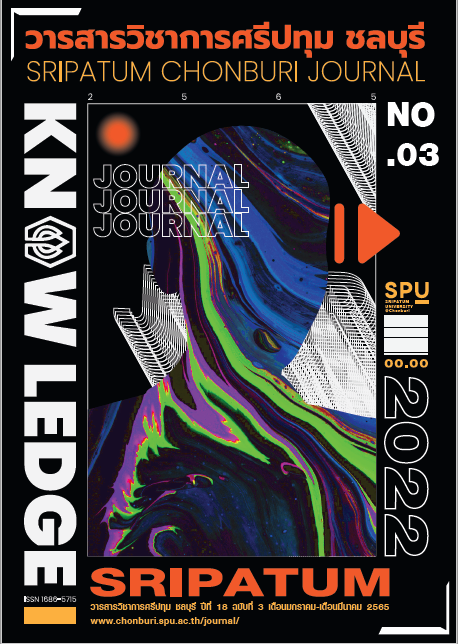THE FRAMEWORK DESIGN OF EVALUATION KEY ELEMENTS IN TECHNOLOGY TRANSFER FOR THAILAND CONTEXT
Keywords:
technology evaluation, technology transfer (TT), technology readiness level (TRL), commercializationAbstract
งานวิจัยนี้มีวัตถุประสงค์เพื่อพัฒนากรอบการประเมินใหม่ของการถ่ายทอดเทคโนโลยี (EFTT) ซึ่งเป็นกรอบการประเมินข้ามอุตสาหกรรมแบบใหม่ที่ครอบคลุม เพื่อประเมินองค์ประกอบสำคัญในการถ่ายทอดเทคโนโลยีในประเทศไทย การศึกษานี้ใช้การสัมภาษณ์เชิงลึกร่วมกับคณะผู้เชี่ยวชาญเพื่อค้นหาปัจจัยความสำเร็จที่สำคัญของการถ่ายทอดเทคโนโลยี ร่วมกับการวิเคราะห์ "Cloverleaf Model of Technology Transfer" และวิธีการประเมิน TRL จาก Sandia National Laboratories (SNL) และ สมาคมองค์กรวิจัยและเทคโนโลยีแห่งยุโรป (EARTO) การอภิปรายนำไปสู่การออกแบบ EFTT โดยมีโครงสร้างหลักสองประการ ประการแรก คือ โครงสร้างทางเทคโนโลยี ซึ่งประกอบด้วย 2 ส่วน คือ 1.1) การนำองค์ความรู้/เทคโนโลยีไปใช้ในการวิจัย และ 1. 2) ความสามารถในการใช้ผลิตภัณฑ์จากการวิจัย ประการที่สอง คือ การสร้างองค์ประกอบทางธุรกิจ ซึ่งประกอบด้วยสี่องค์ประกอบดังนี้ 2.1) ความสม่ำเสมอของผลงานวิจัยและความต้องการของผู้ใช้ 2.2) การตลาด 2.3) การจัดการการถ่ายทอดเทคโนโลยี และ 2.4) การคุ้มครองทรัพย์สินทางปัญญา เมทริกซ์ EFTT แบ่งความพร้อมด้านเทคโนโลยีออกเป็น 6 ขั้นตอน 9 ระดับ และ 56 ประเด็นการประเมิน ในที่สุด ผู้บริหารโครงการ/หัวหน้างานสามารถใช้เมทริกซ์ EFTT เพื่อตรวจสอบความคืบหน้าในการถ่ายทอดเทคโนโลยีและกำหนดความล่าช้าหรือคอขวดในกระบวนการวิจัย เมทริกซ์ EFTT แบ่งความพร้อมด้านเทคโนโลยีออกเป็น 6 ขั้นตอน 9 ระดับ และ 56 ประเด็นการประเมิน ในที่สุด ผู้บริหารโครงการ/หัวหน้างานสามารถใช้เมทริกซ์ EFTT เพื่อตรวจสอบความคืบหน้าในการถ่ายทอดเทคโนโลยีและกำหนดความล่าช้าหรือคอขวดในกระบวนการวิจัย เมทริกซ์ EFTT แบ่งความพร้อมด้านเทคโนโลยีออกเป็น 6 ขั้นตอน 9 ระดับ และ 56 ประเด็นการประเมิน ในที่สุด ผู้บริหารโครงการ/หัวหน้างานสามารถใช้เมทริกซ์ EFTT เพื่อตรวจสอบความคืบหน้าในการถ่ายทอดเทคโนโลยีและกำหนดความล่าช้าหรือคอขวดในกระบวนการวิจัย
References
Chirazi, Jacques, et al. (2019). What do we learn from good practices of biologically inspired design in innovation?. Applied Sciences, 9(4),
pp. 1-16.
EARTO. (2014). The TRL scale as a research & innovation policy tool, EARTO recommendations (Online). Available: https://www.earto.eu/wp-
content/uploads/The_TRL_Scale_as_a_R_I_ Policy_Tool_-_EARTO_Recommendations_-_Final.pdf [2020, November 4].
Fernandez, Joseph A. (2010). Contextual role of TRLs and MRLs in technology management (Online). Available:
https://www.semanticscholar.org/paper/Contextual-role-of-TRLs- and-MRLs-in-technology-
Fernandez/c0653db22ea824bd3348b589c2c2f251a385ba5e [2020, November 5].
Heslop, Louise A., McGregor, E., & Griffith, M. (2001). Development of a technology readiness assessment measure: The cloverleaf model of
technology transfer. Journal of Technology Transfer, 26(4), pp. 369–384.
Kalayou, Mulugeta Hayelom, Endehabtu, Berhanu Fikadie, & Tilahun, Binyam. (2020). The applicability of the modified technology acceptance
model (TAM) on the sustainable adoption of ehealth systems in resource-limited settings. Journal of Multidisciplinary Healthcare, 13,
pp. 1827–1837.
Kam-Fai, Michael TSUI. (2020). Commercialization of rehabilitation robotics in Hong Kong (Online). Available:
https://www.sciencedirect.com/science/article/pii/ B9780128149423000155?via%3Dihub [2020, November 4].
Mitchell, John A. (2007). Measuring the maturity of a technology: Guidance on assigning a TRL (Online). Available:
https://cfwebprod.sandia.gov/cfdocs/CompResearch/docs/TRL-Guidance-final.pdf [2020, November 4].
Mohannak, Kavoos, & Samtani, Laxman. (2014). A criteria-based approach for evaluating innovation commercialisation (Online). Available:
https://conference.druid.dk/acc_papers/i1xk9l9pli4 jnefryvacrvpjdy22.pdf [2020, November 4].
Samtani, Laxman Ashok. (2010). Technology transfer evaluation in the high technology industry: An interdisciplinary perspective. Doctorial
Dissertation of Philsophy, School of manangment, Faculty of Bussiness, Queensland University of Technology, Australia.
Sharabi, Moshe. (2015). Customer focus. In S. M. Dahlgaard-Park (Ed.), Encyclopedia of Quality and the Service Economy (pp. 114-118).
New York, NY: SAGE.
Sung, Tae Kyung, & Gibson, David V. (2005). Knowledge and technology transfer grid: Empirical assessment. International Journal of
Technology Management, 29(3–4), pp. 216-230.
Wahab, Sazali Abdul, et al. (2009). A review on the technology transfer models, knowledge-based and organizational learning models on
technology transfer. European Journal of Social Sciences, 10(4), pp. 550-564.
Downloads
Published
Issue
Section
License

This work is licensed under a Creative Commons Attribution-NonCommercial-NoDerivatives 4.0 International License.
บทความทุกบทความเป็นลิขสิทธิ์ของวารสารวิชาการศรีปทุม ชลบุรี



